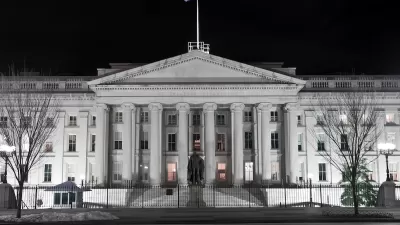The increasing investment value of real estate has led to tangible changes in the way buildings are designed and function, one author argues.

In what Leilani Farha, United Nations special rapporteur on adequate housing, calls "the financialization of housing," the rise in real estate investment has radically reshaped cities and "supersede[d] the traditional role of buildings," writes Nate Berg in Fast Company to introduce an interview with author Matthew Soules.
In the recently published book Icebergs, Zombies, and the Ultra Thin: Architecture and Capitalism in the Twenty-First Century, Soules "argues that value creation is being prioritized over the fundamental purposes of buildings and homes."
"The title of the book calls out three of the ways this is manifesting. Icebergs are the homes of the superrich in London that, due to building height rules, can see their values increased by adding new levels deeper and deeper below ground. Zombies are the half-dead neighborhoods in places like Dublin and southern Spain where speculative development and investment homes often sit empty. Ultra-thins are the tall luxury towers now popping up in cities around the world that serve less as places to live than as places to invest and grow the buyer’s money."
In the interview, Soules explains that these manifestations of finance capitalism are signs of the ways cities are being reshaped to serve capital and increase the liquidity of a traditionally non-liquid asset despite the needs of residents. In Soules' hometown of Vancouver, which is experiencing a huge demand for apartments with two or more bedrooms, "developers continue to build one-bedroom apartments and make their profits this way, to sell out projects over 50% to people who seem drawn to the investment power of the one-bedroom apartments that they then go and rent out, or in some cases let sit empty." According to Soules, "the logics of investment capital are having this slow but profound effect over time, that’s happening so in front of our eyes that it’s hard to even see, of diminishing the social richness of our living environments."
FULL STORY: How capitalism is reshaping cities (literally)

Americans May Be Stuck — But Why?
Americans are moving a lot less than they once did, and that is a problem. While Yoni Applebaum, in his highly-publicized article Stuck, gets the reasons badly wrong, it's still important to ask: why are we moving so much less than before?

Using Old Oil and Gas Wells for Green Energy Storage
Penn State researchers have found that repurposing abandoned oil and gas wells for geothermal-assisted compressed-air energy storage can boost efficiency, reduce environmental risks, and support clean energy and job transitions.

Placekeeping: Setting a New Precedent for City Planners
How a preservation-based approach to redevelopment and urban design can prevent displacement and honor legacy communities.

San Francisco’s Muni Ridership Grew in 2024
The system saw its highest ridership since before the Covid-19 pandemic, but faces a severe budget shortage in the coming year.

Colorado Lawmakers Move to Protect BRT Funding
In the face of potential federal funding cuts, CDOT leaders reasserted their commitment to planned bus rapid transit projects.

Safe Streets Funding in Jeopardy
The Trump administration is specifically targeting bike infrastructure and other road safety projects in its funding cuts.
Urban Design for Planners 1: Software Tools
This six-course series explores essential urban design concepts using open source software and equips planners with the tools they need to participate fully in the urban design process.
Planning for Universal Design
Learn the tools for implementing Universal Design in planning regulations.
Heyer Gruel & Associates PA
City of Moreno Valley
Institute for Housing and Urban Development Studies (IHS)
City of Grandview
Harvard GSD Executive Education
Salt Lake City
NYU Wagner Graduate School of Public Service
City of Cambridge, Maryland





























